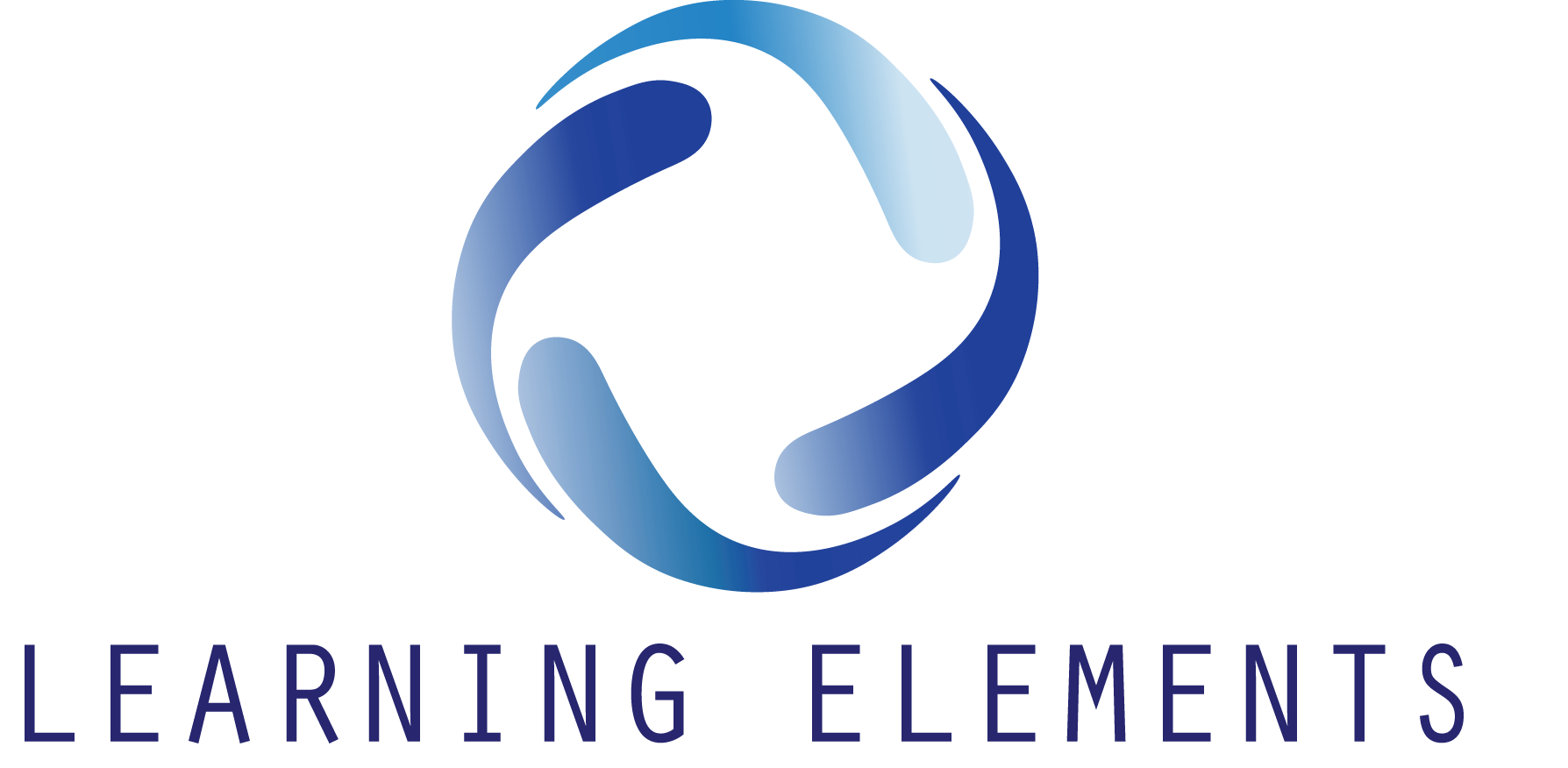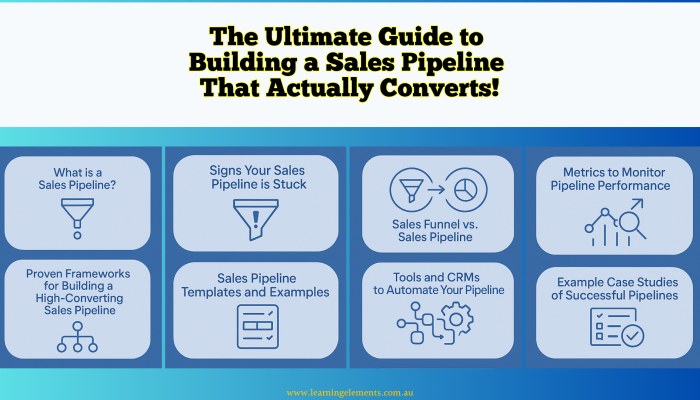The Ultimate Guide to Building a Sales Pipeline That Actually Converts
In today’s fast-moving sales environment, building a sales pipeline isn’t just a best practice—it’s essential. A clear, structured pipeline lets you track prospects, see where each deal stands, and forecast revenue with more accuracy. More importantly, it helps you understand why some deals move forward while others stall.
What is a Sales Pipeline?
A sales pipeline is a visual representation of your sales process. It shows where each prospect is in the journey from lead to customer. Think of it like a roadmap that helps your sales team move leads through different stages until they make a buying decision.
Why Sales Pipelines Are Crucial for B2B and B2C Businesses
Regardless of whether you’re closing enterprise software deals or selling consumer products, a sales pipeline helps you:
- Prioritise leads that are most likely to convert.
- Allocate resources efficiently.
- Improve communication between marketing and sales.
- Forecast revenue with greater accuracy.
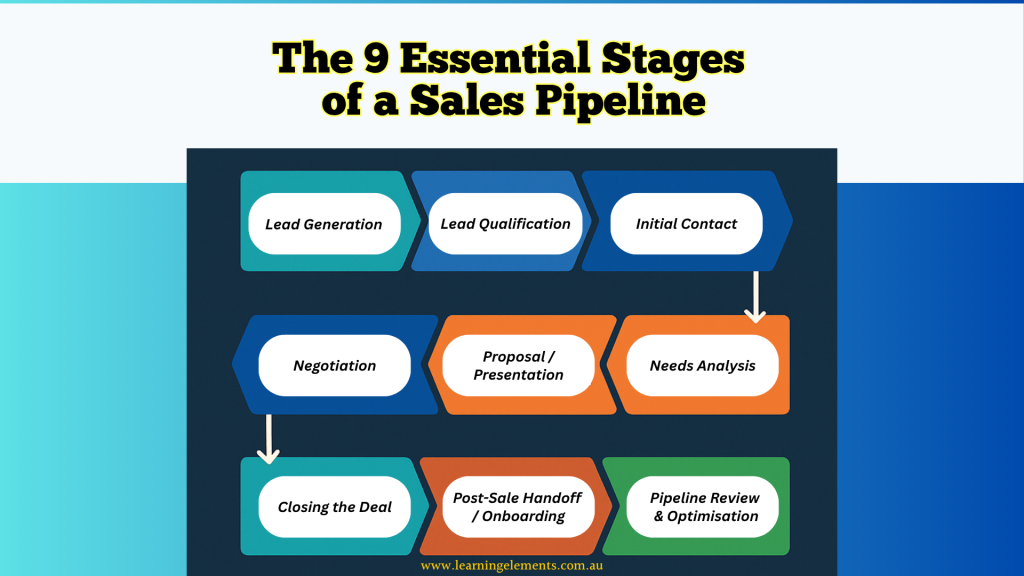
The 9 Essential Stages of a Sales Pipeline
A high-performing pipeline isn’t built on hope—it’s built on a repeatable process. Here’s how to structure it step-by-step:
1. Lead Generation
This is where it all begins. You identify potential buyers through inbound marketing, outbound prospecting, referrals, and events. Quality here affects every downstream result.
2. Lead Qualification
Now, it’s time to separate the browsers from the buyers. Use frameworks like BANT or CHAMP to score leads based on budget, authority, need, and timeline.
3. Initial Contact
Make that first touchpoint count—whether it’s a cold email, a LinkedIn message, or a discovery call. The goal is to open a line of communication and set up a deeper conversation.
4. Needs Analysis
At this stage, ask questions that uncover pain points, buying triggers, and desired outcomes. This is where SPIN Selling and consultative selling shine.
5. Proposal/Presentation
Here’s where you showcase how your product or service addresses their unique challenges. Tailored presentations work far better than cookie-cutter pitches.
6. Negotiation
You’ve won them over—but now comes the fine print. Be prepared for questions about pricing, terms, and service levels. Flexibility and transparency are key.
7. Closing the Deal
This is the point where verbal agreements turn into signed contracts. If terms, pricing, and approvals are in place, the deal is formally closed and marked as won. It’s also where coordination begins for the customer handoff to onboarding or success teams. While it marks the end of the sales process, it should also trigger a short review: What worked, what slowed things down, and what can be improved for next time.
8. Post-Sale Handoff / Onboarding
This stage focuses on the transition from sales to delivery or customer success teams after a deal is closed. It involves internal handovers, kick-off calls, onboarding documents, and alignment on next steps with the customer. The goal is to deliver on what was promised during the sales process and set the foundation for retention, satisfaction, and future growth.
9. Pipeline Review & Optimisation
This stage involves regular analysis of pipeline performance to identify what’s working, what’s stuck, and where improvements are needed. It includes tracking conversion rates at each stage, reviewing deal velocity, analysing forecast accuracy, and adjusting strategies based on data. The goal is to keep the pipeline efficient, aligned with buyer behaviour, and responsive to market shifts.
Some teams include post-sale handoff and regular pipeline reviews as official stages to ensure continuous optimisation.
Sales Funnel vs. Sales Pipeline
Though often confused, a sales funnel represents conversion rates through the journey, while a sales pipeline reflects actions taken by your team at each stage.
| Sales Funnel | Sales Pipeline |
|---|---|
| Focuses on conversion rate | Focuses on action steps |
| Visualises buyer behavior | Tracks seller activity |
| Narrows as it moves forward | Linear progression through stages |
They’re two sides of the same coin, and when used together, provide 360° visibility.
Proven Frameworks for Building a High-Converting Sales Pipeline
BANT (Budget, Authority, Need, Timing)
This framework helps qualify leads quickly so you’re not wasting time on unlikely prospects.
MEDDIC
- Metrics
- Economic buyer
- Decision criteria
- Decision process
- Identify pain
- Champion
Perfect for complex, high-value sales environments.
SPIN Selling
This method emphasises:
- Situation
- Problem
- Implication
- Need-payoff
It’s ideal when a consultative sales approach is required.
Want your team trained on BANT, SPIN, or MEDDIC the right way? Enrol in our Sales Pipeline Training Course or request a customised sales workshop for your business.
Tools and CRMs to Automate Your Pipeline
Here are top-rated CRMs:
- HubSpot CRM – Excellent for growing teams.
- Salesforce – Perfect for enterprise-level operations.
- Pipedrive – Visual pipeline management made simple.
Use automation to schedule follow-ups, segment leads, and generate insights.
Common Pitfalls in Sales Pipelines
A few mistakes can sabotage your entire sales process:
- Lack of Follow-Up: Studies report that the average B2B deal needs eight or more touchpoints to close. Ghosting kills conversion.
- Poor Qualification: Wasting time on bad leads hurts momentum.
- Ignoring Data: Metrics tell a story. If you’re not measuring, you’re guessing.
Signs Your Sales Pipeline is Stuck
Feel like your deals are dragging? Look out for:
- Stalled deals at the proposal stage.
- Too many leads, not enough closes.
- Inconsistent forecasting and revenue dips.
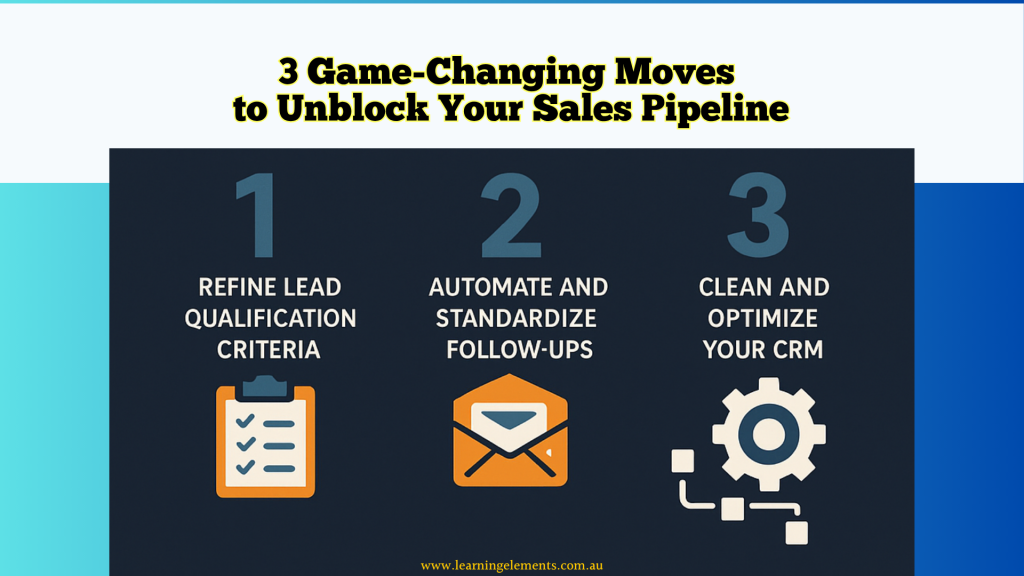
3 Game-Changing Moves to Unblock Your Sales Pipeline
These three actions can revive even the most sluggish pipeline:
1. Refine Lead Qualification Criteria
Most pipeline slowdowns start with bad-fit leads clogging the top.
Implement a Proven Framework Like MEDDIC or BANT
- MEDDIC ensures a deep understanding of the buyer’s decision process.
- BANT helps quickly identify budget-ready, authority-backed leads.
Align your sales and marketing teams around these definitions for better-qualified opportunities.
2. Automate and Standardise Follow-Ups
Your best lead might not convert because they didn’t get that second or third nudge.
Use Sequences, Reminders, and Email Tracking
Tools like HubSpot, Outreach, and Salesloft let you build multi-step sequences with reminders, open notifications, and link tracking to maintain momentum.
3. Clean and Optimise Your CRM
Your CRM should be your team’s most trusted tool—not their biggest frustration.
Audit Stages, Update Tags, Eliminate Duplicates
- Remove outdated or dead opportunities.
- Standardise fields like “deal stage” and “next steps.”
- Create reports that highlight pipeline gaps before they grow.
RELATED READ: Why Your Sales Pipeline Is Stuck — and the 3 Game-Changing Moves to Unblock It
Industry Benchmarks When Building a Sales Pipeline
When building a sales pipeline, it’s not enough to track internal metrics—you also need to understand how your performance compares to others in your industry. These benchmarks help sales teams set realistic goals, spot underperforming stages, and prioritise improvements.
Here are the most commonly tracked benchmarks across key B2B industries:
| Metric | SaaS / Tech | Professional Services | Manufacturing / Industrial |
|---|---|---|---|
| Win Rate | 20–25% (average) | 30–35% typical* | 25–40%* |
| Average Sales Cycle | 60–75 days (startups + SaaS) | 45–75 days* | 90–120 days* |
| Lead-to-Customer Conversion | 5–8% MQL to W | 8–10% | 3–6% |
| Pipeline Coverage Ratio (Pipeline ÷ Quota) | 3–4x | 2.5–3x | 4–5x |
*Benchmarks for specific verticals (e.g. professional services, manufacturing) may vary and should be compared against internal data when available.
Source: HubSpot 2024 Sales Benchmark Report, HockeyStack 2023 SaaS benchmarks
How to Use These Benchmarks?
- Set stage-specific targets: If your win rate is 15% and your industry average is 25%, focus on improving lead quality and later-stage conversion.
- Review pipeline velocity: A slow cycle may be normal in your sector (e.g. enterprise software), but not for short-cycle B2B services.
- Adjust coverage goals: Use industry norms to validate your pipeline targets and avoid under-pipeline planning.
Note: Benchmarks are directional, not definitive. Factors like company size, average deal value, geography, and buyer persona can all influence your pipeline metrics. If you’re just starting out or refining your pipeline strategy, these numbers give a useful lens—but always compare them alongside your internal trends.
Metrics to Monitor Pipeline Performance
| Metric | Why It Matters |
|---|---|
| Pipeline Velocity | Tells you how fast deals move |
| Win Rate | Measures close efficiency |
| Stage Conversion Rate | Pinpoints pipeline leaks |
Track these weekly to improve accuracy.
Looking to track the right pipeline KPIs in real time? Explore our LMS tools or request a sales performance audit to get started!
Sales Pipeline Templates and Examples
Sample Pipeline for SMBs:
- New Lead
- Discovery Call
- Proposal Sent
- Contract Sent
- Closed Won
SaaS Sales Pipeline Example:
- MQL
- SQL
- Demo Scheduled
- Trial Started
- Purchase Decision
- Closed Won
Aligning Sales and Marketing Teams
When sales and marketing don’t align:
- Leads fall through the cracks.
- Messaging becomes inconsistent.
- Revenue suffers.
Hold joint planning meetings, use shared dashboards, and define MQL/SAL/SQL together.
Pipeline Forecasting for Revenue Accuracy
Use models like:
- Weighted Forecasting
- Historical Trend Forecasting
- AI-Based Predictive Forecasting
Forecasting ensures you’re prepared for peaks and valleys in demand.
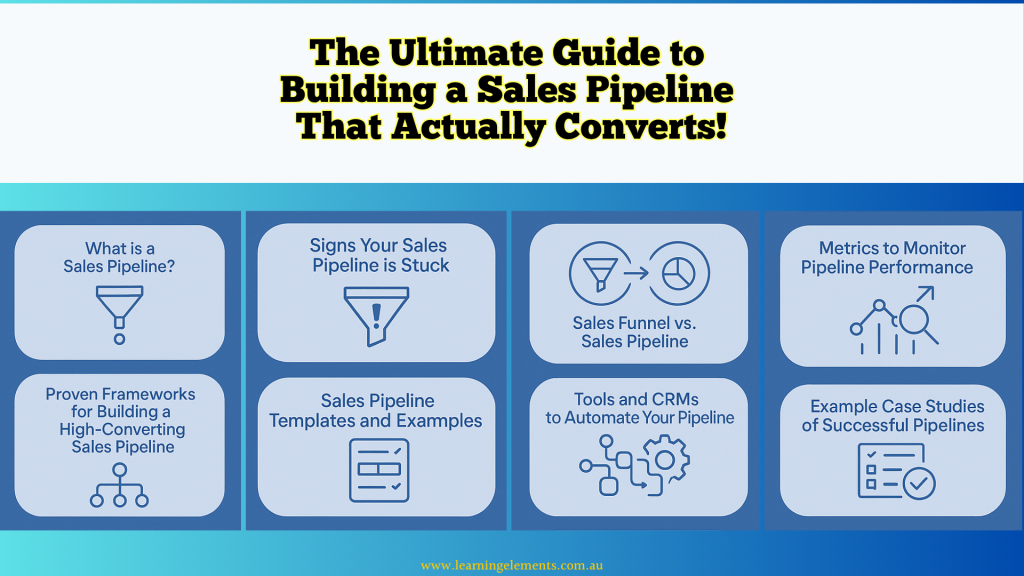
What Works: Case Studies on Building a Sales Pipeline and Driving Revenue
Case Study 1: ERP Company Builds $10M Sales Pipeline with Lead Express
Reported by Lead Express, this B2B case involved an ERP provider focused on Australia’s construction sector. Through structured outbound sales development, the company aimed to enhance its market presence and create more qualified opportunities.
Type
B2B SaaS / ERP | Construction Sector | Mid-Market
Approach
- Strategic account targeting
- Cold outreach using email, phone, and LinkedIn
- Executive-level sales conversations
- Dedicated team support for messaging and follow-ups
- Ongoing performance review and iteration
Highlights
- Identified and engaged ideal customers in a highly targeted industry
- Accelerated positioning within the construction vertical
- End-to-end sales development support delivered externally
Key Metrics
- 63 qualified B2B sales opportunities created
- $10 million in sales pipeline revenue added
- High-value pipeline generated within a relatively short campaign period
Key Impacts
- Expanded brand visibility in a niche sector
- Reduced internal sales team load
- Accelerated pipeline growth with measurable ROI
Significance
This case shows how a structured, outbound-focused lead generation strategy can quickly establish a presence in a target market and generate high-value sales opportunities—especially effective for B2B businesses with complex or long sales cycles.
Disclaimer: Figures are based on Lead Express’ internal reporting.
Case Study 2: xGrowth Pipeline Acceleration Program
xGrowth, an Australian ABM consultancy, shared results from its podcast and blog around improving deal velocity in stalled pipelines.
Type
B2B Tech – Pipeline Acceleration (Late-stage velocity)
Approach
- Targeted ABM strategies applied to open opps already in the CRM
- Created urgency through tailored messages, 1:1 landing pages, and content
- Trigger-based outreach based on CRM stages and inactivity
- Involved sales directly in the acceleration content
Key Impacts
- Re-engaged 30–60 day stalled deals
- Improved close rate and reduced time-to-close
- Created new behaviours in late-stage pipeline management
Significance
Not all pipeline fixes are top-of-funnel. This proves how ABM and content targeting stalled deals mid-pipeline can help unlock revenue faster.
Case Study 3: B2B Sample Pipeline Framework by Campaign Pipeline
Rather than a single-client result, this is a strategic framework compiled by CampaignPipeline.ai, based on examples from tech and SaaS companies.
Type
B2B Campaigns – Full-Funnel Pipeline Architecture
Pipeline Stages
- Awareness Campaigns
- Lead Nurture Drip
- SQL Alignment
- Intent + Demo Offers
- Sales Follow-up Tracks
- Recycle & Re-engage
Approach
- Maps out attribution-friendly strategies that tie into actual pipeline metrics
- Offers tactical breakdowns of what to run at each stage of a pipeline
- Includes real campaign examples used by SaaS, tech and consultancies
Significance
This acts as a blueprint for anyone designing their B2B sales pipeline from scratch, especially in service and software industries.
Future Trends
- AI-Driven Personalisation – Real-time content suggestions.
- Predictive Lead Scoring – ML models flag high-likelihood leads.
- Sales Enablement Automation – Reps get content and tools automatically.
FAQs
- How long should a sales pipeline be? Ideally, 5–7 stages to balance granularity with simplicity.
- Can I use Excel instead of a CRM? Technically yes, but CRMs offer automation and analytics that Excel can’t.
- How do I know if my pipeline is working? High conversion rates, fast deal cycles, and accurate forecasts are green flags.
- What’s a healthy win rate? Most industries average 20–30%. Higher rates are possible with tight qualification.
- How often should I update my pipeline? Daily is ideal. Weekly at minimum.
- How do I prioritise leads? Use lead scoring based on behaviour (e.g. email clicks, site visits), engagement (e.g. replies, demo bookings), and fit—how closely they align with your ideal customer profile.
Conclusion
Building a sales pipeline that succeeds long-term means recognising it isn’t static—it evolves with your business. By structuring your stages, avoiding common pitfalls, and integrating proven frameworks, you’ll build a system that converts leads consistently.
Remember: The key isn’t just getting leads in—it’s moving them through efficiently. That means staying clear on what qualifies a lead at each stage, keeping your team aligned on next steps, and regularly reviewing where deals get stuck. Whether you’re optimising outreach, tightening qualification, or accelerating close rates, the goal is to keep momentum across the entire pipeline.
A well-managed approach to building a sales pipeline improves conversion rates and gives sales leaders stronger forecasting, resource control, and long-term confidence.
Ready to start building a sales pipeline that delivers real growth?
Contact our team for business consulting, tailored sales enablement, or a no-obligation strategy session.
Sources
- HubSpot – 2024 Sales Trends Report. Link
- HockeyStack – 2023 SaaS benchmarks Link
- Lead Express – “Case Study: Propelling a Market Position and Generating $10 Million in Pipeline Revenue for an ERP Company with Lead Express.” Link
- xGrowth – “Podcast: How to Roll Out Pipeline Acceleration.” xGrowth Blog. Link
- Campaign Pipeline – “Sample Pipeline for B2B Sales Teams.” CampaignPipeline.ai. Link
